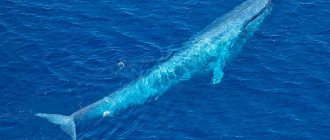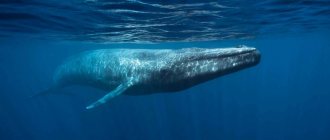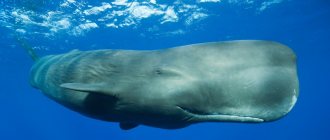The seas and oceans are home to many creatures that are similar in physique to fish, but at the same time breathe air, give birth to live young and feed them with milk. An example of this is the blue whale.
The blue whale is the greatest traveler among marine mammals. They go to sea only occasionally. Their home is the world's oceans. At the moment, there are 11,000 of these huge animals left in the world's oceans and therefore hunting for this whale is now prohibited.
Whales can stay awake for months
If necessary, whales can easily go without sleep for three months. Well, they sleep almost on the surface of the water. The body of a whale has a high content of light adipose tissue, so the weight of the animal slightly exceeds the specific gravity of water. So the sleeping whale slowly sinks to the depths, and after a while hits its tail in its sleep, after which it rises to the surface again. Here, after inhaling air, the animal again begins to slowly descend deeper. Until the next tail swipe.
Unfriendly abyss
The sun only warms the surface of the oceans and seas. Already at a depth of several meters, the water becomes a couple of degrees colder. And from three to four kilometers its temperature drops to 0°C and even lower, depending on the degree of salinity and latitude.
However, the cold at depth is not the biggest problem for living things. Much more terrible is the monstrous pressure of the mass of water. On earth we experience pressure of one atmosphere. Given that water is approximately 800 times more dense than air, every 10 meters of depth increases the pressure by another atmosphere. Consequently, three kilometers deep in the ocean, all living and nonliving things are under the pressure of 300 atmospheres.
Previously, scientists believed that a person would literally be flattened at a depth of several kilometers. Later it turned out that the danger threatens only the places where the tissues come into contact with the cavities of the middle ear and other air sinuses in the head, as well as with the lungs. Even small changes in pressure can damage them, and high pressure will simply crush these organs.
The whale is the largest animal on the planet
The largest whales are blue ones. And they are probably the largest creatures that have ever inhabited the planet.
On average, the length of a whale is from 22 to 27 meters, females are always larger than males. The largest known whale was caught in 1926; it reached a length of 33 meters, and the weight of the animal was 150 tons. Some scientists believe that whales used to be even larger; they simply became smaller due to whaling. So, there is some evidence that among blue whales there were real giants up to 37 meters.
The weight of a whale's heart alone is 600-700 kg, and its vessels are about the diameter of a bucket. About 8 thousand liters of blood flow through these arteries.
Anatomical features
Now it’s worth considering the description of the whale from a physiological point of view. This animal is a mammal, and it is warm-blooded. Accordingly, each whale breathes with the help of its lungs, and the females feed their calves with milk. And these creatures have hair, albeit reduced.
Because these mammals are exposed to the sun, their skin has protection from ultraviolet rays. True, it is expressed differently in each species. A blue whale, for example, can increase the content of special pigments in its skin that absorb radiation (in simple terms, it “tans”). The sperm whale protects itself from oxygen radicals by triggering a “stress response.” The fin whale practices both methods.
By the way, these creatures maintain their warm-bloodedness due to the presence of a thick fatty layer under the skin. It is this that protects the internal organs of marine animals from hypothermia.
How do whales hear?
Whales do not have external ears, but listen through their throats. And to be more precise, the lower jaw. From it, sound penetrates to the middle and inner throat.
Whales also have very poor eyesight and no sense of smell, so hearing is the only way to navigate the ocean and get food. Therefore, ships and other external noise caused by humans cause enormous inconvenience to whales.
Oxygen saving methods
Less effort, more oxygen
When swimming, whales exert minimal effort. When they submerge, blood is transported only to those parts of the body that need oxygen: the heart, brain and muscles, which they use for nothing; thus, they retain oxygen longer.
bradycardia
Whales reduce their heart rate, a process known as bradycardia, to reduce the amount of oxygen they consume.
High resistance to carbon dioxide (CO2)
Whales have a high tolerance to carbon dioxide (CO2), much higher than that of any other mammal; this allows them to submerge in the ocean for a long time.
Breathe with conscience
Whales are considered conscious respites as they try to swim and hunt as little as possible to conserve oxygen.
In addition, these animals never fall asleep completely, as loss of consciousness for a long period of time can mean death from suffocation.
During the break, half of the whales' brains sleep, while the other half remains alert to act quickly if they need oxygen or need to escape from predators.
In this sense, whales rarely achieve the state of deep sleep characterized by rapid eye movement (MOR).
How much does a whale eat?
Whales consume an incredible amount of calories: they eat about three tons of food per day. The main “dishes” are small crustaceans and algae, sometimes small fish and squid. True, they eat only in the summer, and for about 8 months a year they eat practically nothing; they survive due to accumulated fat. And, as a result, in the summer, whales simply eat all day long, devouring everything in their path.
Belukha
This is a representative of the toothed whales of the narwhal family. The beluga whale is not very large. Its weight reaches only 2 tons, and its length is 6 meters. Beluga whales have excellent hearing, acute perception of any sounds, and the ability to echolocation. In addition, these are social creatures - there are known cases in which these whales saved a person. They get along well in aquariums, over time they get used to people, and even become attached to workers.
Their diet is varied. Beluga whales eat cod, flounder, herring, clams, algae, shrimp, lamprey, rib jellyfish, pink salmon, gobies, blennies, crayfish and many other sea creatures that are suitable for food.
These creatures, like many others, also suffered due to human cruelty. Whalers easily drove them onto the shallows, and the belugas literally crashed. But at the moment this species is gradually restoring its numbers. Let's just hope people don't ruin anything.
There are dozens of other representatives of cetaceans, and all are special and interesting in their own way. And we hope that every species that we know of will survive. The marine world should not lose any of them, as each of them is a true wonder and natural treasure.
The closest relatives of whales are hippos
The hypothesis states that the ancestors of whales lived on land and walked on four legs. However, during the course of evolution, they descended into the ocean in search of food. At first they simply hunted fish in the water and went ashore to rest, but due to competition with other animals, the ancestors of whales had to go further and further. So they remained to live in the ocean. This happened about 50 million years ago.
All cetaceans (including dolphins) are descendants of artiodactyls. Well, the closest relative of the whale is the hippopotamus. They descended from a single ancestor who lived on the planet 54 million years ago.
Name
The first step is to answer the question that worries many. And it sounds like this: “Is a whale a fish or a mammal?” The second of the proposed options is correct.
The whale is a large marine mammal that is not related to porpoises or dolphins. Although they are included in the order Cetacea (cetaceans). In general, the situation with names is very interesting. Pilot whales and killer whales, for example, are considered whales. Although, in accordance with the strict official classification, they are dolphins, which few people know.
And it is better to trust a strict classification, since in the old days leviathans - sea multi-headed monsters that could devour the planet - were called whales. In a word, the name has an interesting story.
What kind of milk do whales have?
Everyone knows that whales are mammals and feed their young with breast milk. For a long time, scientists only speculated how this could happen, but a couple of years ago, environmentalists managed to film a baby feeding. Whale mother's milk is very thick and has a consistency similar to toothpaste. It is rich in protein and the fat content is 50%. The cub receives about 90 liters of milk from the mother per day; on average, feeding lasts 7 months. So how does this happen?
The fact is that females have nipples covered with a layer of skin, thanks to which they easily glide through the water. Babies do not have flexible lips with which they can wrap around the nipple, like ordinary mammals. Therefore, feeding occurs as follows: the baby swims up to the mother, dives under her, and at the moment of this contact the mother bends her abdominal muscles and exposes her nipple, splashing milk into the baby’s mouth. Then the baby swims away from the mother, and then returns again, the process repeats. Amazing coherence and interaction!
At birth, the cub reaches approximately 9 meters in length, and by the age of one and a half years it grows to 20 meters and gains weight up to 45-50 tons.
Flying high and deep. 10 interesting facts about dolphins and whales
Dolphins are mammals belonging to the order Cetaceans. They live in seas, oceans, bays and rivers all over the world. Adult river dolphins reach sizes from 1.2 m in length, and sea dolphins – up to 9.5 m. The brain is the largest organ of the dolphin’s body; in relation to body weight, it is almost the same as that of a human. www.globallookpress.com
Due to the smooth, elastic skin, the friction force of water on the dolphin’s body is minimal, which allows the mammal to develop greater speed. The average speed of a dolphin is 5-11 km/h, the fastest dolphins reach speeds of up to 37 km/h. www.globallookpress.com
When dolphins sleep, they turn off one part of the brain and the opposite eye, while the other part of the brain functions to remind the dolphin to rise to the surface in time and take a breath of air, and the awake eye watches for danger around. www.globallookpress.com
Dolphins' hearing is unique. Mammals have their own system of sound signals: echolocation signals, which are used to find food, detect obstacles and explore the situation; and “whistle” signals that provide communication between dolphins. Dolphins within a community have names by which they distinguish each other. The high-frequency sound signals of dolphins are inaccessible to the human ear; the hearing of mammals is 400-1000 times sharper. www.globallookpress.com
Dolphins breathe air, they have lungs and a blowhole, which is an extension of the nose. On average, they are able to hold their breath for 7.25 minutes. The record breath holding time for a mammal is 15 minutes. www.globallookpress.com
The whale is the largest mammal existing on earth. Belongs to the order of cetaceans and lives in sea water. The blue whale, whose length can exceed 30 m, is the largest animal in the world. It weighs about 125 tons. www.globallookpress.com
Just like dolphins, whales breathe air. They rise to the surface every 5-10 minutes for a new breath, and to completely change the air in their lungs, whales blow a fountain through the breathing hole on the front of their heads. Some whales can freely spend up to 45 minutes underwater without taking a single breath. www.globallookpress.com
All cetaceans, including whales, dolphins and porpoises, are descendants of mammals of the artiodactyl order that left land and went to sea. The structure of a whale's fins resembles that of a hand with five fingers, and some whales have bones where the hind legs should be. www.globallookpress.com
The whale is the only mammal on the planet, other than humans, that sings. The shortest whale song lasts 6 minutes, and the longest one lasts more than half an hour. www.globallookpress.com
Instead of teeth, the blue whale has several hundred fatal plates in its mouth, they are called whalebones. To dine, the whale just needs to open its mouth and swim through the accumulation of shellfish, shrimp or fish. Then the whale closes its mouth and forcefully pushes the water out of its mouth through the whalebone, like through a sieve, and the prey remains inside. www.globallookpress.com
Blue whales are monogamous
Whales are very social animals, they communicate with each other. It is reliably known that blue whales are monogamous animals, they form a married couple for a long time, and the male does not leave the female under any circumstances, they always stay close to each other.
Healing fat
We have known about the beneficial properties of fish oil since childhood, and it was for this substance that whales were killed for many centuries. Dense fatty cover is also necessary for the whales themselves: it protects them from the cold, so whales can safely navigate even the coldest seas. In some individuals, the body fat content reaches 50% of the total mass. In addition, fat increases buoyancy and makes the animal’s body more streamlined. Fat reserves are especially important for species that migrate long distances, such as humpback whales. During their travels, they survive solely on their own subcutaneous fat. Another interesting fact: at great depths, the eyes of whales begin to secrete... fatty tears! They protect their eyes from salt and help improve visibility.
The outdated name for whale oil is blubber. This substance is obtained from the blubber of whales and other aquatic mammals; it has a yellow or brown color and an unpleasant odor. Blubber has always been one of the main products of whaling. Some peoples of the North still use whale oil as food and fuel for lamps. In addition, blubber was previously used in the production of rawhide and suede.
People believed that you could live in the stomach of a whale
There used to be many legends that people could survive in the stomach of a whale. So, there is biblical confirmation of this: the prophet Jonah spent three days and three nights in the belly of a whale. And also remember the fairy tale about Pinocchio and the famous Disney cartoon, where the woodworker Geppetto was swallowed by a whale.
People believed that after a shipwreck, if sailors were swallowed by a whale, they could live in its stomach for months. What a journey!
However, what is it really? A person simply cannot penetrate through the throat: it is the size of a small plate. But there are whales that can swallow a person whole, these are sperm whales. But their stomach has very high acidity, so it is impossible to survive there.
Units
So, now – about the types of whales. Or rather, about suborders. The first species is baleen whales. They are the largest of modern mammals. Their physiological feature is a mustache with a filter-like structure.
The second species is toothed whales. Carnivorous, fast creatures. They are superior to toothless whales. Only the sperm whale can compare in size with them. And their feature, as you might have guessed, is the presence of teeth.
And the third species is ancient whales. Those that no longer exist. They belong to a paraphyletic group of animals from which modern species of whales later evolved.
Whales can talk
And not only among themselves. Whales are capable of imitating human speech. For a long time they did not believe in this, but scientists conducted an experiment on the beluga. The mammal was trained to make sounds on command and sensors were attached to it. It turned out that the beluga “talks” in the following way: it sharply increases the pressure in the nasal cavities and thereby causes the phonic lips (formations in the nasopharynx, with the help of which cetaceans make sounds) to vibrate.
Perfumers' treasure
The most famous of all toothed whales is the sperm whale. At one time, it was considered the treasured trophy of every whaler, and all thanks to the magical spermaceti. Spermaceti is a fatty, waxy substance found in the sperm whale's head. People have found a lot of different uses for it. In the 18th century, candles were made from spermaceti; later they began to use it as a lubricant and a base for the preparation of creams and ointments.
But sperm whales were even more prized for their ambergris, a hard, waxy substance that is secreted in the sperm whale's intestines. Ambergris is formed when damage occurs to the whale's intestinal walls. Most often these are cracks from the horny beaks of squids and other cephalopods, which the sperm whale “dined” on at its leisure. Now that whaling is prohibited, the only way to get ambergris is to find pieces of it (it is hard) washed ashore. Currently, almost all collected natural ambergris is instantly bought up by perfume companies to make expensive perfumes.
Reproduction
The peak of mating for blue whales occurs in winter: in January in the northern hemisphere and in July in the southern hemisphere. The body length of newborns is from 6 to 8.8 m, more often 7-8 m, with a weight of 2-3 tons. A strong variation in the size of embryos obtained at the same time indicates that mating periods are extended over almost the entire year. An analysis of the size of embryos in Antarctic catches showed an average increase in their body in November by 35 cm, in December by 56, in January by 72, in February by 92 and in March by 79 cm (Tomilin, 1957). Apparently, the growth rate of the embryos gradually increases, but towards the end of uterine life it slows down somewhat.
Pregnancy lasts a little less than a year (about 11 months). Usually one cub is born; cases of multiple births are rare. According to the International Whaling Statistics (ISS), among 12,106 Antarctic embryos, there were 77 cases of twins, five cases of triplets, one find with five and one with seven embryos. Of the twin embryos, as a rule, only one develops to the end, the rest die and are resorbed. During the 7-month lactation period, the cub, feeding on very fatty milk (34-50% fat), grows up to 16 m and weighs 23 tons, and at the age of 19 months it reaches 20 m and weighs 45-50 tons; medium individuals (23.7-24 m) weigh 80-85 tons, and large ones (30 m) - 150-160 tons (Wheeler and Mackintosh, 1929; Krogh, 1934; Ruud, 1956). Puberty occurs at 4-5 years, as evidenced by 8-10 layers in the ear plugs, which are used to determine age. Females at this time reach a length of 23 m. They reach full growth and physical maturity at a body length of 26-27 m, which probably happens at 14-15 years.
The average daily weight gain of sucklings, according to zootechnical calculations (Tomilin, 1946), reaches 81.3 kg with a daily consumption of 90 kg of milk. Puberty occurs at 4-5 years, when 8-10 layers appear in the ear plugs, which are used to determine age (Nishiwaki, 1957); at this time, the length of southern females reaches an average of 2-3.78 m, northern ones - 23 m, and the average weight of the testes of males is 10 kg (Ruud, 1950, 1957). Females usually breed every two years. The strong variation in the percentage of pregnant females among sexually mature ones (from 20 to 61%: Laurie, 1937; Ottestad a. Ruud, 1936) depends on the accuracy of registration of embryos at whaling bases and on the number of individuals studied (with less material, larger deviations are possible).
Females reach physical maturity when 11-12 scars of the corpus luteum accumulate in the ovaries; this occurs at 14-15 years of age, and possibly at an even older age, with an average body length of 26.2 m (Laurie, 1937), 26.5 m (Brinkmann, 1948) and 26.67 m (Peters, 1939 ). The minimum size of physically mature Antarctic females is set at 24.7 m, and for males - 22.3 m. A female with 41 scars of the corpus luteum (18 in one ovary and 23 in the other) already had signs of menopause, and with 35 scars was without such signs . The oldest female in the North Pacific has only 25 scars (Omura, 1955).
Big and fast
Whales have fantastic speed for their size. The fin whale is considered the fastest: representatives of this species can reach speeds of over 45 kilometers per hour in times of danger. For a long time, scientists have been struggling with this mystery: according to all the laws of physics, whales simply have nowhere to get the energy to move so quickly underwater. Trying to find answers, researchers created wooden models of whales and towed them underwater, but the numbers just didn’t add up.
Everything became clear only after a frame was created with an elastic outer covering that imitated the skin and fat of a whale. It turned out that it is thanks to the elasticity of the outer tissues that whales are able to develop such a high speed for their weight. They are very sensitive to water pressure, and the movements of their fins reduce friction with the water.
Long-lived giants
Whales are famous long-livers. Some species can live to be 100 years or more. And the record holder for life expectancy among vertebrates has long been considered the bowhead whale, which lived 211 years. Blue whales live on average about 80-90 years. The oldest individual of this species lived to be 110 years old.
According to some scientists, the long life of whales is facilitated by their regular diving into icy water. But there is another point of view. Geneticists who studied the DNA of whales discovered that these animals have unique mechanisms that suppress the development of cancerous tumors and can slow down aging. So, perhaps, a more detailed study of whales will soon give humanity the secret of eternal youth.











